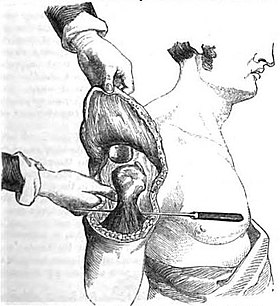Flap (surgery)
| Flap surgery | |
|---|---|
| Intervention | |

A flap used to cover an amputation stump
|
|
| ICD-9-CM | 86.7 |
Flap surgery is a technique in plastic and reconstructive surgery where any type of tissue is lifted from a donor site and moved to a recipient site with an intact blood supply. This is similar to but different from a graft, which does not have an intact blood supply and therefore relies on growth of new blood vessels. This is done to fill a defect such as a wound resulting from injury or surgery when the remaining tissue is unable to support a graft, or to rebuild more complex anatomic structures such as breast or jaw.
The skin can be divided into three main layers including the epidermis, the dermis, and the subcutaneous tissue. Blood is supplied to the skin mainly by two networks of blood vessels. The deep network lies between the dermis and the subcutaneous tissue, while the shallow network lies within the papillary layer of the dermis. The epidermis is supplied by diffusion from this shallow network and both networks are supplied by collaterals, and by perforating arteries that bring blood from deeper layers either between muscles (septocutaneous perforators) or through muscles (musculocutaneous perforators). This redundant and robust blood supply is important in flap surgery because part of the supply will be cut off. The remaining blood supply must then keep the tissue alive until a more optimal supply can be restored through angiogenesis.
An angiosome is a three-dimensional region of tissue that is supplied by a single artery and can include skin, soft tissue, and bone. Adjacent angiosomes are connected by narrower choke vessels and so multiple angiosomes can be supplied by a single artery. Knowledge of these supply arteries and their associated angiosomes is useful in planning the location, size, and shape of a flap.
Flaps can be fundamentally classified by their level of complexity, the types of tissues present, or by their blood supply.
Flaps can be classified according to level of complexity. The surgeon should choose the least complex type that will achieve the desired effect, a concept known as the reconstructive ladder.
Local flaps are created by freeing a layer of tissue and then stretching the freed layer to fill a defect. This is the least complex type of flap and includes advancement flaps, rotation flaps, and transposition flaps, in order from least to most complex. With an advancement flap, incisions are extended out parallel from the wound, creating a rectangle with one edge remaining intact. This rectangle is freed from the deeper tissues and then stretched (or advanced) forward to cover the wound. The flap is disconnected from the body except for the uncut edge which contains the blood supply which feeds in horizontally. A rotation flap is similar except instead of being stretched in a straight line, the flap is stretched in an arc. The more complex transposition flap involves rotating an adjacent piece of tissue, resulting in the creation of a new defect which must then be closed.
...
Wikipedia
